Editor’s Note: The launch date for AWE has moved to Nov. 1, 2023. The title and launch date have been updated to reflect the change.
NASA’s Atmospheric Waves Experiment, or AWE, is set to launch in November 2023. From its perch aboard the International Space Station 250 miles above Earth, AWE will study atmospheric gravity waves to better understand how they transport energy into Earth’s upper atmosphere and affect space weather.

Gravity waves, also known as buoyancy waves, are a common phenomenon that connect the lower and upper atmospheric regions by transporting heat and momentum upwards. They’re created near Earth’s surface by atmospheric disturbances such as air flowing over mountains and severe weather like thunderstorms and tropical cyclones. These different sources produce gravity waves with very different sizes and speeds that, up until now, have been very difficult to measure comprehensively from space with one instrument.
AWE’s two-year mission will, for the first time, remotely measure a broad range of sizes and speeds of gravity waves as they travel through the atmosphere, 50 miles above Earth’s surface. These measurements will provide new information about the sources of gravity waves, how they travel, and how they vary with the seasons. By better understanding the physics of gravity waves, scientists will better understand – and be better equipped to forecast – key processes affecting atmospheric weather, space weather, and climate.
Measuring the energy that gravity waves transport to the upper atmosphere is critical for understanding how terrestrial weather affects space weather. Space weather is caused when high-energy radiation and particles from the Sun interact with Earth’s magnetic field and upper atmosphere. Space weather effects can disrupt GPS navigation and radio communications systems, and they also pose a threat to spacecraft in low Earth orbit. The amount of energy transported by gravity waves into the upper atmosphere is an important missing piece of information for understanding space weather effects.
AWE will join NASA’s fleet of heliophysics satellites studying the vast interconnected system that includes the space surrounding Earth and other planets out to the farthest limits of the Sun’s constantly flowing stream of solar wind. AWE will complement NASA’s other upper-atmospheric missions such as the Ionospheric Connection Explorer and the Global-scale Observations of the Limb and Disk, which both study features in the upper atmosphere on larger scales than AWE.
AWE is led by Michael Taylor at Utah State University in Logan, and it is managed by the Explorers Program Office at NASA’s Goddard Space Flight Center in Greenbelt, Maryland. Utah State University’s Space Dynamics Laboratory is building the AWE instrument and will provide the mission operations center.
By Mara Johnson-Groh
NASA’s Goddard Space Flight Center, Greenbelt, Md.
